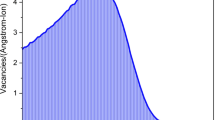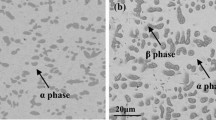Abstract
Cu metal, surrogate for metallic actinide materials, was subject to accelerated aging through thermal treatment. A multiphase oxide-layer (Cu2O, CuO) was detected, varying with temperature (250–400 °C) and aging time (1–3.5 h). Isotope ratio mass spectrometry revealed temperature-dependent isotopic fractionation of O, evidenced by the enrichment of Cu oxide in 16O isotopes with increasing temperature. Isotopic fractionation occurred initially with atmospheric O, and later through exchange with water vapor. Raman spectra contributed insight on phase fraction and local bonding of Cu oxides. O isotopes could serve as a useful tracer for studying oxide layer growth from aging metallic systems.






Similar content being viewed by others
References
Nuclear Forensics and Attribution Act [Public Law 111–140, 111th Congress]. https://www.congress.gov/bill/110th-congress/house-bill/2631/text. Accessed 14 Jul 2017
Haschke J (2000) Surface and corrosion chemistry of plutonium. Los Alamos Sci 26:252–273
Pajo L (2001) Investigation of the oxygen isotopic composition in oxidic uranium compounds as a new property in nuclear forensic science. J Anal Chem 371:348–352
Stakebake J (1977) The high temperature oxidation of plutonium-3.3 a/o Gallium. J Electrochem Soc 124(3):460–465
Lohrengel M (1987) Growth, corrosion and capacity of copper oxide films investigated by pulse techniques. Electrochim Acta 32(5):733–742
Chan H (1999) Oxide film formation and oxygen adsorption on copper in aqueous media as probed by surface-enhanced raman spectroscopy. J Phys Chem B 103(2):357–365
Niedrig-Schedel T (2000) Copper (sub)oxide formation: a surface sensitive characterization of model catalysts. J Chem Phys 2:2407–2417
Kendall C, McDonnell J (1998) Fundamentals of isotope geochemistry: isotope tracers in catchment hydrology. Elsevier Science B.V, Amsterdam
Yapp C (1993) Oxygen isotopes in iron (III) oxides. Chem Geol 85(3):329–335
Graham M (1993) The growth and stability of passive films. Corros Sci 35(1–4):13–18
Hussey R (1996) The influence of reactive-element coatings on the high-temperature oxidation of pure-Cr and high-Cr-content alloys. Oxid Met 45:349
Brady M (2014) Tracer film growth study of hydrogen and oxygen from the corrosion of magnesium in water. J Electrochem Soc. https://doi.org/10.1149/2.0821409jes
Plekhanov V (2001) Isotope effects on the lattice dynamics of crystals. Mater Sci Eng R Rep 35(4–6):139–237
Koreiba M (1993) Isotope effects in the lattice structure and vibrational and optical spectra of Li/Li-YF: Ho crystals. J Exp Theor Phys 77(6):1021–1033
Korzhavyi P (2011) Literature review on the properties of cuprous oxide Cu2O and the process of copper oxidation. Swedish Nuclear Fuel and Waste Management Co. Internal Report. TR-11-08
Ebisuzaki Y (1985) Oxidation kinetics of copper. J Chem Educ 62(4):341–343
Biccari F (2009) Defects and doping in Cu2O. Sapienza Universita di Roma. PhD thesis
Wang Y (2016) Electronic structures of Cu2O, Cu4O3, and CuO: a joint experimental and theoretical study. Phys Rev B 94(24):245418
Debbichi L (2014) Electronic structure, lattice dynamics and thermodynamic stability of parameltaconite Cu4O3. Mater Chem Phys 148:293–298
Zhou G (2003) Dynamics of copper oxidation investigated by In Situ Uhv-Tem. University of Pittsburgh. PhD thesis
Jae Won L (2006) Brief review of oxidation kinetics of copper at 350°C to 1050°C. Metall Mater Trans A 37A:1231–1237
Gattinoni C (2015) Atomistic details of oxide surfaces and surface oxidation: the example of copper and its oxides. Surf Sci Rep 3(70):424–447
Garrison L (2015) The effects of tungsten’s pre-irradiation surface condition on helium-irradiated morphology. J Nucl Mater 466:302–311
Lappin D (2012) An experimental study of electrochemical polishing for micro-electrodischarge-machined stainless-steel stents. J Mater Sci Mater Med 23(2):349–356
Bertrand N (2010) Iron oxidation at low temperature (260–500 °C) in air and the effect of water vapor. Oxid Met 73:139–162
Boxhammer J (2001) Shorter test times for thermal- and radiation-induced ageing of polymer materials: 1: acceleration by increased irradiance and temperature in artificial weathering tests. Polym Test 20(7):719–724
Hagemann H (1990) Raman Spectra Of Single Crystal CuO. Solid State Commun 73(6):447–451
Levitskii V (2015) Raman spectroscopy of copper oxide film deposited by reactive magnetron sputtering. Tech Phys Lett 41(11):1094–1096
Zheng Y (2012) In-situ Raman monitoring of stress evaluation and reaction in Cu2O oxide layer. Mater Lett 78:11–13
Holmlund J (2009) Two-magnon Raman scattering from the Cu3O4 layers in (Sr2,Ba2)Cu3O4Cl2. Phys Rev B Condens Matter 79:085109
Zoolfakar A (2014) Nanostructured copper oxide semiconductors: a perspective on materials, synthesis methods and applications. J Mater Chem C 2:5247–5270
Gulbransen E (1961) Oxidation of copper between 250°C and 450°C and the growth of CuO ‘Whiskers’. J Electrochem Soc 108(2):119–123
Wei T (1990) Raman scattering of cupric oxide (CuO). Simon Fraser University. Masters Thesis
Lee S (2016) Oxidation behavior of copper at a temperature below 300°C and the methodology for passivation. Mater Res 19(1):51–56
Meyer B (2012) Binary copper oxide semiconductors: from materials towards devices. Phys Status Solidi B 249(8):1487–1509
Wang Y (2016) Electronic structures of Cu2O, Cu4O3, and CuO: a joint experimental and theoretical study. Phys Rev B Condens Matter 94(24):245418
Bernstein R (1955) Oxygen-18 isotope effect in the reaction of oxygen with copper. J Chem Phys 23:10
Brown J (1957) Fractionation of oxygen isotopes in the formation of oxide films on copper. J Chem Phys 27:251
Kroopnick P (1972) Atmospheric oxygen: isotopic composition and solubility fractionation. Sci 175(4017):54–55
Yapp C (1990) Oxygen isotopes in iron (III) oxides: 1. Mineral-water fractionation factors. Chem Geol 85(3–4):329–335
Zheng Y (1991) Calculation of oxygen isotope fractionation in metal oxides. Geochim Cosmochim Acta 55:2307–3399
Friedman I, O’Neil J (1977) Compilation of stable isotope fractionation factors of geochemical interest. Government Printing Office, New York
Sauders W (1981) Reaction rates of isotopic molecules. Wiley, New York
Lee X (2006) Water vapour 18O/16O isotope ratio in surface air in new England, USA. Tellus B Chem Phys Meteorol 58(4):293–304
Galewsky J (2016) Stable isotopes in atmospheric water vapor and applications to the hydrologic cycle. Rev Geophys 54:809–865
Acknowledgements
This work was supported by the U.S. Department of Homeland Security (DHS) Domestic Nuclear Detection Office (DNDO) Academic Research Initiative (ARI) under Grant 2015-DN- 077-ARI093. The views presented in this paper are those of the authors do not necessarily reflect those of U.S. Dept. of Homeland Security (DHS), DNDO, or the ARI. This material is also based upon work supported under an Integrated University Program Graduate Fellowship. Any opinions, findings, conclusions or recommendations expressed in this publication are those of the author(s) and do not necessarily reflect the views of the Department of Energy Office of Nuclear Energy. This paper has been reviewed and released under LA-UR-20-23722.
Author information
Authors and Affiliations
Corresponding author
Additional information
Publisher's Note
Springer Nature remains neutral with regard to jurisdictional claims in published maps and institutional affiliations.
Rights and permissions
About this article
Cite this article
Bishop, J.L., Unger, R., Faiia, A.M. et al. Thermal signatures of Cu metal revealed through oxygen isotope fractionation. J Radioanal Nucl Chem 326, 1653–1662 (2020). https://doi.org/10.1007/s10967-020-07456-3
Received:
Accepted:
Published:
Issue Date:
DOI: https://doi.org/10.1007/s10967-020-07456-3




